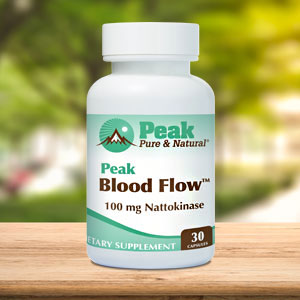Get Easy Health Digest™ in your inbox and don’t miss a thing when you subscribe today. Plus, get the free bonus report, Mother Nature’s Tips, Tricks and Remedies for Cholesterol, Blood Pressure & Blood Sugar as my way of saying welcome to the community!
‘Precondition’ your blood pressure to lower risk of stroke and heart attack

Do you know my least favorite moment during doctor’s visits? When the doctor inflates the blood pressure cuff around my arm and it squeezes my arm super tight.
It’s uncomfortable and I can’t wait until it’s over. It turns out, though, that moment of pain is worth what I gain in my brain (I’m a poet and I didn’t even know it).
You see, healthy organs need healthy blood flow. Blood brings oxygen, and without enough oxygen, vital organs like your heart and brain don’t do well. In fact, dramatic decreases in blood (and oxygen) is what triggers heart attacks and strokes.
But there is a way to make organs like your heart and brain more resilient to changes in blood flow and decreases in oxygen (and consequently, more resilient against strokes and heart attacks) … by training them to get used to changes in blood and oxygen levels.
That’s exactly what happens when your doctor inflates that blood pressure cuff. For a moment, it reduces the blood flow (and oxygen) to your heart and brain. And there’s evidence that if you did this consistently it could “train” your heart and brain to resist heart attacks and strokes…
What remote ischemic preconditioning can do for your heart and brain
You’ve probably never heard of remote ischemic preconditioning. I hadn’t until recently, so let me explain…
Remote ischemic preconditioning is the process of applying compression to your arms and legs to restrict blood flow and oxygen to organs like your heart and brain. The goal is to get them used to changes in blood flow and oxygen, so these changes are less likely to trigger a heart attack or stroke.
Previous research shows that remote ischemic preconditioning can, in fact, make the heart less vulnerable to serious heart attack-related damage. And now, a new study shows it can benefit the brain too…
In a small study of 50 people, researchers from Jilin University in China tested the effect of ischemic preconditioning on the brain.
Participants were an average age of 35, and each of them went through a remote ischemic preconditioning process. Blood pressure cuffs were placed on one upper arm and one thigh and inflated for five minutes. Then they were deflated for five minutes. This process was repeated four times.
Next, researchers used ultrasound to measure blood flow to two main brain arteries. They also measured blood flow regulation. All this was measured before participants went through remote ischemic preconditioning too. And guess what?
Six hours after preconditioning, participants had improved blood flow regulation to the brain which lasted 24 hours. They also had an increase in two blood biomarkers that are known to protect the nervous system and an increase in biomarkers that improve inflammation and immunity. In fact, one of these biomarkers (glial cell line-derived neurotrophic factor) not only protects against stroke but other neurological disorders like Parkinson’s and epilepsy too.
Don’t try this at home, folks… at least not yet
Before you start slapping on blood pressure cuffs daily, there’s something you should know…
You shouldn’t try restricting blood flow on your own because it can be dangerous. This should only be done under a doctor’s supervision. Besides, we need more research on remote ischemic preconditioning before the benefits are set in stone. But maybe one day, you’ll be able to use remote ischemic preconditioning to protect yourself from heart attacks and strokes. Here’s hoping.
In the meantime, there are other ways you can improve blood flow regulation in your brain. Blood flow regulation throughout your whole body (brain included) is controlled by your circulatory system (i.e. heart, blood vessels, and heart). And you can strengthen your circulatory system through regular exercise… especially cardio.
You can also encourage healthy blood flow to your brain (and elsewhere) through deep breathing exercises. There are many deep breathing methods to choose from. You can try yogic pranayama, which has been practiced for centuries. Or something newer, like the Wim Hof Method, which comes with some promising testimonials so far. Whatever you do, act now to keep your blood flow in tip-top shape, so your brain stays stroke-free.
Editor’s note: Have you heard of EDTA chelation therapy? It was developed originally to remove lead and other contaminants, including heavy metals, from the body. Its uses now run the gamut from varicose veins to circulation. Click here to discover Chelation: Natural Miracle for Protecting Your Heart and Enhancing Your Health!
Sources:
- Could repeated squeezes to the arms, legs protect the brain? — EurekAlert!
- Remote Ischemic Preconditioning and Renoprotection: From Myth to a Novel Therapeutic Option? — Journal of the American Society of Nephrology
- How to improve circulation — Medical News Today













